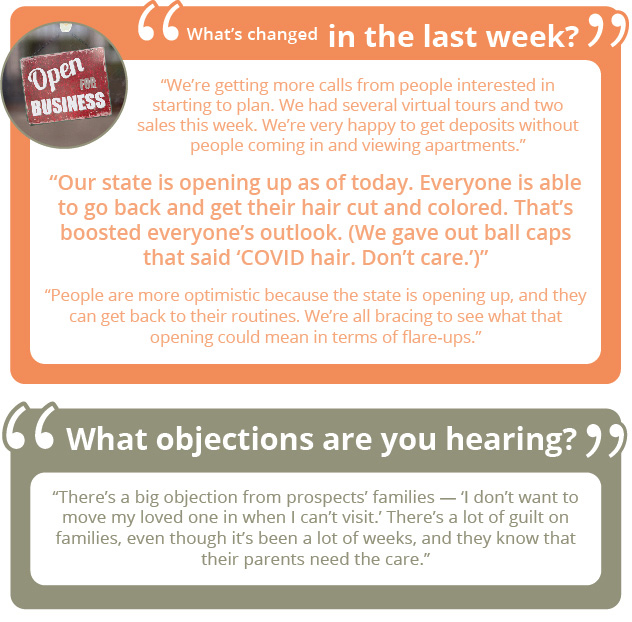Communities in different parts of the country came together last Thursday to share their thoughts and challenges as shutdowns continue. Jackie Stone, VP of sales at Varsity, joined our general discussion to share insights on virtual event topics and processes during social distancing.
Check out the takeaways below. You are also welcome to join our next sales & marketing roundtable, coming up this week.

Jackie leads a discussion on virtual presentations:
- Presentation objectives
- New lead generation
- Use the purchased email list and lead base
- Select universal topics of interest to anyone
- Ensure that the presentation represents the lifestyle at the community and reinforces the established brand
- Sales presentation
- Target the lead base
- Address common objections
- “I’m not ready yet.”
- “I want to stay independent.”
- “I’ve lived here for 50 years; I don’t know where to start.”
- “This apartment is so small.”
- “I don’t want to live with all old people.”
- “How would I even go about selling my home?”
- “The economy/stock market is unstable.”
- Personalize to the prospect
- Customized to each individual prospect — what he or she values in life and in a community
- New lead generation
- Potential presentation topics
- New lead generation
- Mindfulness — Putting Your Practice Into Place
- Healthy Aging: Achieving Wellness in All Dimensions
- Living a Big Life
- Dispelling the Myths of Retirement Living
- Sales presentations
- Decluttering Your Life to Make Room for Experiences
- Living a Big Life
- Bridging the Gap Between “I’m Not Ready Yet” and “I Wish I Had Done This Sooner”
- Protecting Your Nest Egg
- Does a Life Plan Community Make Sense for Me?
- Selling Your Home in a Virtual World
- Personalizing to the prospect
- Presentation of the community’s services, amenities, residences and benefits
- Video walking tour of the community
- Happy hour Zoom call
- New lead generation
- Marketing automation
- Targeting prospects
- Email seminar invitation
- Confirmation and login instructions
- Resending of seminar invitation to those that did not open the original email
- Reminder email two days prior to the event
- Communicating with those who did attend
- Post-webinar “Thank you for joining us”
- Survey
- What other topics might interest you?
- Schedule a private appointment?
- Next seminar invitation
- Communicating with those who did not attend
- “We missed you” email
- Schedule a private appointment?
- Next seminar invitation
- Targeting prospects
- Typical attendance expectations
- We’ve seen anywhere from 7–10, 25–30 and close to 50, so it can really vary.
Where are you doing to go from here with marketing?
- It depends on your community.
- Examples:
- One community is stretched for dollars because of the current bond market.
- Other communities may have more money to spend, with cancelling in-person marketing events.
- You may need to move dollars around in your budget. The focus will need to be on engaging prospects in blue sky projects. If you don’t use the money this year, you won’t have it next year! Spend it wisely, and don’t let it go.
- An AL community in New York has online events/speakers every week. It’s very buttoned up and structured — link to check out: https://inspireseniorliving.com/events.
- I think we’ll be Zooming for a long time.
- Follow these virtual call tips.
- Do a roll call.
- Ask what participants miss during this time of quarantine. If they say Starbucks, deliver a coffee to their doorstep.
- Examples:
Join the next sales & marketing roundtable on June 4!
We thank everyone for participating, and we invite you to join the next session on Thursday, June 4, at 12 p.m. ET.
You don’t have to be a client to join — all are welcome. For call-in information, email DDunham@VarsityBranding.com.


